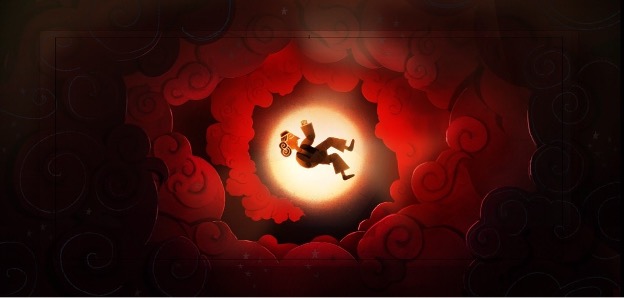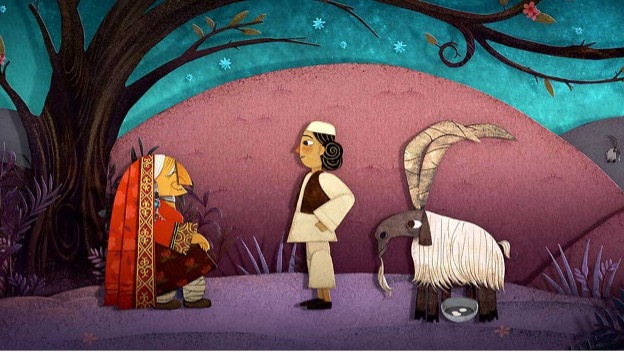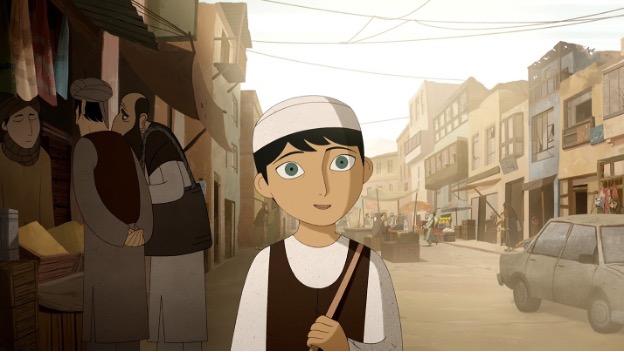
The Breadwinner is a 2D animated film about an Afghan Muslim girl’s desperate attempt to support her family. The film follows an 11-year-old girl, Parvana, who cuts her hair and dresses up as a boy to work for the family after her father is imprisoned. Produced by Angelina Jolie and directed by Nora Twomey, the film is set right before the American invasion of Afghanistan in 2001. Even though the film was released in 2017, it is more relevant today than in the year of its release considering the recent rise of the Taliban after the US exit from Afghanistan in 2021. This post will examine the technical aspects of the film’s storytelling techniques as well as the film’s distinct symbolism which is effective in relaying its darker themes. It will explore how Parvana is represented as a young girl navigating a society produced by war and religious conflict.
It will also explore her grief over her brother’s death after he stepped on a landmine. It is no surprise that oral storytelling is used to deliver key aspects of the plot when we consider its importance in Afghan culture (see Bezhan, 2013). Whenever a story is being told in the film, the animation style changes to one-dimensional looking characters that resemble dolls rather than the two-dimensional ones in the present, and the scenes are also flattened out, illustrating a unique artistry. The scenes are sometimes abstract and symbolic as seen in the opening image of Parvana’s sleeping brother circling around in red and orange clouds that are reminiscent of a fetus in utero [see figure 1].

Throughout the story, we see her brother, Sulayman, appear frequently in Parvana’s developing story about a boy from a village who takes on the task of fighting an elephant king [see figure 2]. We learn at the end of the film that Sulayman died when he picked up a landmine. He defeats the elephant king after he makes that admission, illustrating that the elephant king represented Parvana’s suppressed grief and that this admission was a reconciliation with her loss. The storytelling also has some Orientalist aspects to it. For instance, during a quick story about Afghanistan’s history, the audience sees camels on the move even though Afghanistan is not in the Middle East.
Another type of symbolism came in the form of Parvana herself who is meant to draw parallels to the most famous Afghan woman in Western imagination, Sharbat Gula, whose iconic photo appeared in one of the most memorable National Geographic covers ever (see Northup, 2020). Parvana has a similar complexion and bright green eyes just like Gula, and in the movie’s poster, she also wears a red scarf like Gula in her famous photo. While the film must be commended for bringing to light the oppressive rule of the Taliban, it regurgitates long-held stereotypes of Islam as an oppressive religion to women and girls, even though Taliban rule in Afghanistan is unique even for the Islamic world. With that said, it is made clear in the film that illiteracy is an issue even for men in Afghanistan which is represented as a destitute country.

Parvana eventually makes an alliance with a male vendor in the market after she helps him to read a letter because he is illiterate. This alliance proves to be effective because it leads to the eventual rescue of her father. Once Parvana starts working under the pretense of a boy, she runs into her old school friend, Shauzia, who also poses as a boy [see figure 3]. After both girls rekindle their friendship, Shauzia shows Parvana a postcard of a beach and as they stare at it, the background of an abandoned spot with decaying army tanks possibly from the Soviet-Afghan war is also visible, illustrating the contrast between both scenes. This combination symbolizes the somber condition of the girls’ lives under Taliban rule, while alluding to the danger of them posing as boys.
Despite its issues, The Breadwinner is still an important film that sheds light on not just the history of Afghanistan but also its depressing state in our contemporary times. It illuminates the struggles of a society frequently at war amid the backdrop of religious fundamentalism. But it also explores hope amid despair and the power of human connection.
References
Bezhan, Faridullah (2013) “Storytelling, Myth, and the Afghanistan Wars in Spozhmai Zaryab’s Anti-war Short Stories”. In Storytelling, Self, Society: Vol. 9: Iss. 2, Article 2.
Northrup, Tony & Chelsea. “The disturbing true story of the Afghan Girl photo (READ DESCRIPTION)”. February 28, 2019. 14:42. URL: https://youtu.be/RuFKpaV_jjo. Last accessed March 4, 2023.
Safiyya Hosein is a part-time lecturer at Toronto Metropolitan University and holds a PhD in Communication and Culture. Her research focuses on Muslim representation in popular culture. Her work is published in peer-reviewed journals such as Popular Culture Studies Journal and The Journal of Graphic Novels and Comics. Her public scholarship can be found at The Conversation, and she has been interviewed by the CBC, Spice Radio, and several international media outlets. In 2017, she was selected by Vice Media Motherboard for their “Humans of the Year” series.

1 comment for “Representations of Muslim Trauma in The Breadwinner (2017)”